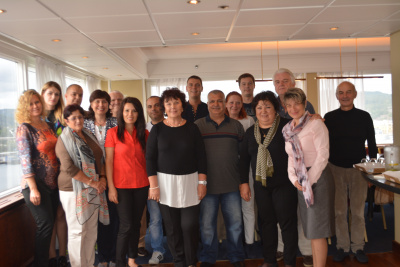Roma and Health Awareness 2
Date posted
Project – "Increasing the capacity of teachers at the Medical University Plovdiv in training with a focus on health awareness of the Roma community". This project focuses on providing appropriate (in the sense of both form/delivery and content) information about health awareness to the Roma community in Bulgaria.
Partners – Roma 1995 Regional Development Foundation (NGO, Bulgaria), CBNRM Networking (NGO, Norway), and Medical University Plovdiv. The latter partner is responsible for implementing the project.
Funding – Grant from: Program BG09, EEA Scholarship Fund, Inter-institutional Cooperation Measures, under the EEA Grants.
Activity – In the activity reported on here, a group of 20 persons from Medical University Plovdiv and Roma 1995 Regional Development Foundation travelled to Kristiansand, Norway, on 6-10 September 2016. The purpose was to meet with likeminded organizations and persons, and exchange views on how to provide optimal health awareness training to Roma in Bulgaria, and ethnic minorities more generally. As a representative of the Norwegian partner I organized meetings with stakeholders in public sector (including Kristiansand City and Sorlandet Hospital) and civil society (including Salvation Army), to discuss health awareness training among Roma and ethnic minorities more generally in both countries. The dialogue was constructive as well as forward looking.
Medical University Plovdiv prepared preliminary conclusions from the work so far, together with questions for follow-up, and these were presented and discussed at the various meetings. These are presented below (slightly revised):
(A) Issues in Selecting Roma to Be Involved in the Project (selection criteria: gender, religious affiliation, age group)
- There are a large number of Roma communities, each with their individual habits, cultural characteristics and behavior.
- There is little communication between these communities.
- Some communities are quite difficult to get to interact with.
- Roma communities are not represented by any single NGO.
(B) Evaluation and Assessment of the Impact of the Project, of How Efficient the Project is In Achieving Its Objectives
- Ways of presenting and acquiring the educational material and lessons of the study process.
- The importance of the lessons to the audience.
- How to achieve, assess and analyze the extent of dissemination of the knowledge acquired by the Roma community.
(C) Issues Associated With Implementing Modern Methods of Educating Roma Communities
General questions:
- How to get to know the needs of the Roma community, and anticipate any future issues?
- Who defines the problems of the Roma community, and how is this done?
Educating Roma:
- What is the best way to communicate with Roma?
- How do Roma communities perceive the way we teach them? How to get feedback and assess the impact of this education (methods and statistical analysis)?
How to influence Roma behavior in a positive way:
- Is education sufficient to achieve targeted parameters?
- What societal level should we reach to make sure that present initiatives and money spent to realize them have a beneficial effect:
- The level of Roma communities?
- The level of institutions?
- The level of the state and/or municipalities?
- The regulatory level?
Alternative avenues and scenarios in moving towards a sustainable society:
- Funding Roma (food, homes, recreation).
- Increasing the significance of administrative and regulatory measures.
- Investing in improving the rate of employment.
- Investing in social and cultural activities.
Lars T. Soeftestad
Notes
1/ This article is slightly revised from the original, published on LinkedIn Pulse on 24 September 2016 at: https://www.linkedin.com/pulse/health-awareness-training-among-roma-bulgaria-lars-soeftestad.
2/ Image credit: Lars Soeftestad, Supras Ltd. About: participants in the study tour to Kristiansand (yours truly is behind, to the right).
3/ Project photos: (a) Meeting (Plovdiv, x Oct (?) 2015) - (to be added), (b) Press conference (Plovdiv, x x 2016) - (to be added), (c) Training (Pamporovo, x August 2016) - (to be added), (d) Training (Pamporove, x August 2016) - (to be added), (e) Mobility travel to Norway (Kristiansand, 6-10 September 2016) - https://www.flickr.com/supras/sets/72157674289001155, (f) Press conference (Plovdiv, 27 September 2016) - (to be added)
4/ The project was discussed in the article "Agder og internasjonalisering" (note 7), which was published in the regional daily newspaper "Fædrelandsvennen" on 24 September 2016.
5/ The study visit was presented in the article "Bulgarske leger i Kristiansand" (Norwegian language). This was an interview with me that was published in the regional weekly newspaper "Lokalavisen i Kristiansand" on 21 September 2016.
6/ The Devblog article "Anthropology and Development Aid" is relevant for the present project (note 8). It addresses the role of anthropology in development projects that focus on health issues.
7/ Relevant Devblog articles: "Devblog: on Roma" at: https://www.devblog.no/en/article/devblog-roma | "Roma and health awareness 1" at: https://www.devblog.no/en/article/roma-and-health-awareness-1 | "Train or be trained vs eat or be eaten" at: https://www.devblog.no/en/article/train-or-be-trained-vs-eat-or-be-eaten
8/ Further relevant Devblog articles: EEA and Norway Grants: Evaluation of Own Projects" (to appear) | "EEA and Norway Grants: my project portfolio" at: https://www.devblog.no/en/article/eea-and-norway-grants-my-project-portfolio | "EEA and Norway Grants and evaluation" at: https://www.devblog.no/en/article/eea-and-norway-grants-and-evaluation | "EEA and Norway Grants: donor country partners" at: https://www.devblog.no/en/article/eea-and-norway-grants-donor-country-partners | "Poland and Norway: transparency and trust" at: https://www.devblog.no/en/article/poland-and-norway-transparency-and-trust | "Bulgaria: Roma in the penitentiary system" at: https://devblog.no/en/article/bulgaria-roma-penitentiary-system | "Ethnographic film and advocacy" at: https://devblog.no/en/article/ethnographic-film-and-advocacy | "Anthropology and development cooperation" at: https://www.devblog.no/en/article/anthropology-and-development-cooperation
9/ Permalink. URL: https://devblog.no/en/article/roma-and-health-awareness-2
10/ This article was published 24 September 2016. It was revised 21 February 2023.
Sources
Medical University Plovdiv, project website. n.d. URL: http://www.harc-muplovdiv.com
Soeftestad, Lars. 2015-16. Own fieldnotes.

Add new comment